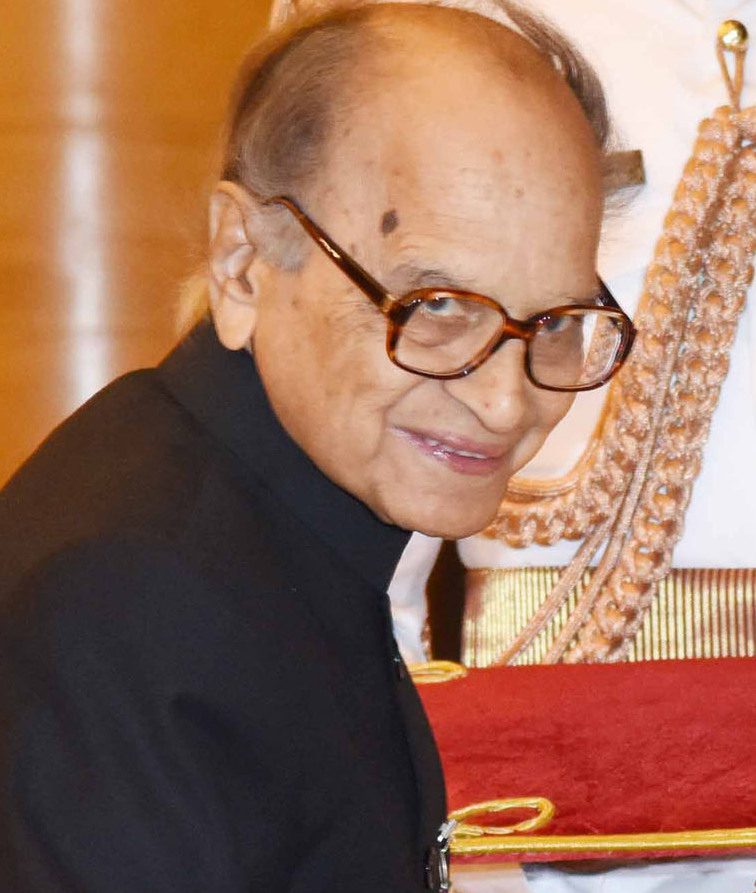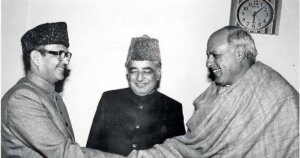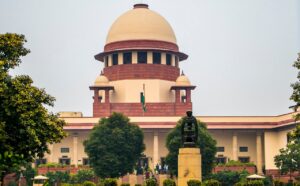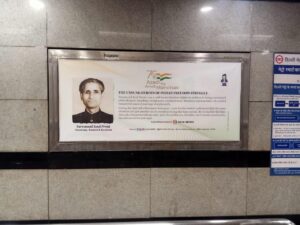The question “Was Jagmohan Responsible for the Kashmiri Pandit Exodus is complex. This situation reflects a deeper political struggle in Kashmir. Two influential figures, Farooq Abdullah and Mufti Mohammad Sayeed, are at the centre of this narrative. Meanwhile, Jagmohan stands as an antagonist.
Was Jagmohan Responsible for the Kashmiri Pandit Exodus, or did history make him the ultimate scapegoat?
Let’s Explore
You know what a love triangle looks like: three hearts, one story, and endless drama.
But have you ever witnessed a hate triangle?
Two powerful men of Kashmir, each nursing a wound, each plotting revenge. Their names were Farooq Abdullah and Mufi Mohammad Sayeed. And in the middle of their hate story was Jagmohan.
This was not just a clash of beliefs; it was a triangle of political hate, drawn in silence rather than ink. It was a fight for survival, and like all such fights, it needed a scapegoat.
Kashmiri Pandits fled. The silence stayed. And Jagmohan became the name everyone blamed.
So, ask again: Was he the reason for the Kashmiri Pandit Exodus? Or just the man history chose to carry the weight?
For more than thirty-five years, this question has split historians, politicians, and survivors. However, the facts are often clouded by politics and narratives that support particular agendas. It is time to re-evaluate the evidence with an open mind.
To understand what happened in Kashmir in 1990, it is necessary to examine the events of the 1980s. This was a decade of political games, betrayal, and growing mistrust.
1984: Dismissal of Farooq Abdullah Government
It began in July 1984. Farooq Abdullah was the Chief Minister of Jammu and Kashmir. He was the son of Sheikh Abdullah and was seen as a popular leader. But his relationship with the central government in Delhi was not good. Indira Gandhi, the Prime Minister, did not trust him.
In Kashmir, politics can change overnight. Some lawmakers from Farooq’s party turned against him. They were led by his brother-in-law, Ghulam Mohammad Shah, known as Gul Shah. The Congress party in Delhi helped Gul Shah. Jagmohan, who was the Governor, played a key role. He dismissed Farooq Abdullah’s government, saying it lost its majority.
Gul Shah Takes Over
After Farooq was removed, Gul Shah became the new Chief Minister. But many Kashmiris did not accept him. They viewed Gul Shah as a puppet of Delhi, rather than a leader chosen by the people. His government was weak. There were many problems, and communal tensions grew.
Mufti Mohammad Sayeed and the Anantnag Riots
By 1986, Mufti Mohammad Sayeed had become one of the most senior leaders in the Congress party in Jammu & Kashmir. He began his career as a local politician in Anantnag and steadily advanced through the ranks. But when he reached the top, he found the door to greater power closed. Many believe that frustration drove him to challenge the government from within, with the hope of paving the way for his leadership.
The Riots That Changed the Game
In early 1986, in the district of Anantnag, Mufti’s political stronghold, a sudden wave of communal violence broke out. Temples were attacked, Hindu homes were vandalised, and thousands of Kashmiri Pandits were targeted. This unrest was a sharp break from Kashmir’s otherwise calm status and shocked many.
It is believed that Mufti Mohammad Sayeed played a direct role in instigating the Anantnag riots. Some sources say he “engineered” the violence to weaken the then government of Ghulam Mohammad Shah, who had become Chief Minister of Jammu & Kashmir after the fall of Farooq Abdullah in 1984.
This communal polarisation created a crisis, giving the central Congress leadership an excuse to dismiss Ghulam Mohammad Shah’s government in March 1986 and impose Governor’s Rule.
However, destiny intervened with its twist.”
Rajiv Gandhi ignored Mufti’s ambitions, choosing instead to mend ties with Farooq Abdullah. The 1986 Rajiv-Farooq Accord brought Abdullah back to power, leaving Mufti sidelined and seething.
That political betrayal laid the groundwork for a storm.
In 1987, elections in the Valley were rigged on an unprecedented scale. Votes were stolen. Opposition voices silenced. Protest turned to rage. And that rage, denied any democratic outlet, found expression in militancy.
Mufti Sayeed and Farooq Abdullah were now locked in a cold war, each waiting for the right moment.
To explore More on the 1987 Election Rigging, read the article here.
It came in 1989.
1989: The Return of Mufi Sayeed
When V.P. Singh formed his government in 1989, the political landscape underwent a dramatic shift. The BJP’s support opened new opportunities to settle old scores. Mufti Mohammad Sayeed fulfilled his long-held dream of power by becoming India’s first Muslim Home Minister. This position gave him significant authority over the governance of Kashmir.
The Strategic Masterstroke Of Mufti Sayeed
With Farooq Abdullah back in the Chief Minister’s seat, Mufti Sayeed executed his calculated revenge. Subsequently, he pushed for Jagmohan’s reappointment as the Governor of Jammu and Kashmir.
This decision was purely strategic rather than administrative. Indeed, Mufti Sayeed was aware of Jagmohan’s history with Farooq. Additionally, he understood that this appointment would provoke strong reactions.
It worked as expected.
Announcing Jagmohan as the new Governor of Jammu and Kashmir, Farooq Abdullah resigned on January 18, 1990.
The next day, on January 19, 1990, Jagmohan was sworn in as Governor.
Reappointment of Jagmohan
The decision to reappoint Jagmohan as Governor of Jammu and Kashmir in January 1990 was not a purely administrative one. It was political. And it was personal.
Mufti Mohammad Sayeed, now Union Home Minister, knew exactly what this move would trigger. Jagmohan had a history with Kashmir. His earlier dismissal of Farooq Abdullah’s government in 1984 still echoed through the state’s political memory. His tough, law-and-order image made him a perfect tool.
Reappointing him was not just about controlling the unrest in the Valley; it was also about maintaining stability in the region. It was about reigniting old rivalries.

January 19, 1990: Jagmohan Takes Charge
On January 19, Jagmohan was sworn in.
It was supposed to be a formal transfer of power, but the air in Kashmir was anything but normal. The Valley was already on the edge. Mobs had taken to the streets. Fear was spreading faster than fire. Jagmohan, still stuck in Jammu due to bad weather, could only listen as reports flooded in. Pandits were being threatened. Loudspeakers from mosques were issuing ultimatums. His appointment, meant to bring control, instead coincided with chaos
In the freezing winter of the Valley, loudspeakers from mosques broadcast threatening slogans. Crowds gathered outside Pandit homes. Walls screamed with graffiti:” Ralliv, Ghalliv Ya Tchalliv.
That night wasn’t an isolated event. It was the culmination of months of terror.
Since September 1989, Pandits had been targeted. Prominent leaders like Tika Lal Taploo had already been assassinated. Threat letters circulated.
Srinagar’s major dailies Aftab and Alsafa published public warnings asking Pandits to leave within 48 hours.
This wasn’t state-led. It was a terrorist led by JKLF and Hizbul Mujahideen.
But because Jagmohan took charge that very night, he became the face of the fallout. For many, he became the villain.
Was Jagmohan the Mastermind?
The theory that Jagmohan is Responsible for the Kashmiri Pandit Exodus
goes like this:
Jagmohan, in coordination with Mufti, engineered the Pandit exodus to give security forces a free hand in Kashmir. By removing the Hindu minority, the Indian state could operate without civilian “obstacles.”
But this theory collapses.
And here is why?
The Exodus and Targeted Killings Began Before Jagmohan’s Arrival
Terrorism and targeted killings of prominent Pandits started months before Jagmohan was reappointed Governor on January 19, 1990.
For example, leaders like Tika Lal Taploo were assassinated in September 1989, Justice Neelkanth Ganjoo in November 1989, and Prem Nath Bhat in December 1989, well before Jagmohan took office.
This timeline shows that the climate of terror against Pandits had been established independently of Jagmohan’s administration.
Jagmohan Was Not Even in Srinagar When the Exodus Began
On January 19, 1990, radical slogans blared from mosques, making Kashmiri Pandits fearful and causing them to flee. Jagmohan stayed at Jammu Raj Bhavan and was unable to reach Srinagar due to the bad weather. He received urgent calls from Pandits asking for help, showing that he was not causing their departure but was facing a situation that was already getting out of control.
Jagmohan Tried to Prevent the Exodus and Called for the Pandits’ Return
Jagmohan publicly appealed to the Pandit community not to leave, even months after the initial exodus had begun. His office issued statements pledging protection and setting up camps for Pandits willing to return. This shows that Jagmohan sought to preserve the community and maintain order.
Barefoot Exodus: The Truth Behind a Misremembered Escape
Most of the people I know escaped in local trucks, often overcrowded with five or six families packed into a single vehicle. They travelled barefoot and carried no belongings, driven only by the urgent need to survive. The reality was raw and desperate. Yet, many still believe that organised buses were arranged for their evacuation, which sharply contrasts with the experiences of those who fled under such harrowing conditions.
Credible Voices Label Jagmohan as a Scapegoat
Ghulam Mohammed Sofi, editor of Srinagar Times, stated in a 1997 interview that blaming Jagmohan was a “total lie” and part of “systematic propaganda,” stressing that the Pandit exodus was planned outside the state and had nothing to do with Jagmohan.
Why Jagmohan Was Blamed Anyway
Because everyone needed a villain.
- Separatists used Jagmohan to deflect blame from militancy.
- Politicians blamed him to cover up their failures.
- Academics and activists found it easier to target a bureaucrat than confront a religious cleansing narrative.
Even within the Pandit community, some also blamed Jagmohan, but the majority of them termed them a rescuer.
But history demands more than scapegoats. It demands honesty.
The Truth We Refuse to Face
Kashmir’s hate triangle was not just personal; it was structural.
- Mufti’s ambition.
- Farooq’s wounded pride.
- Jagmohan’s timing.
Together, they created the perfect storm.
But the real tragedy wasn’t in New Delhi’s appointments or Farooq Abdullah’s resignations.
It was in how easily an entire community was driven out, with no resistance from neighbours, no protection from the state, and no justice even 35 years later.
Want to explore deeper accounts of Kashmir’s political history and firsthand narratives? Browse the curated selection of books on the Kashmir conflict.




